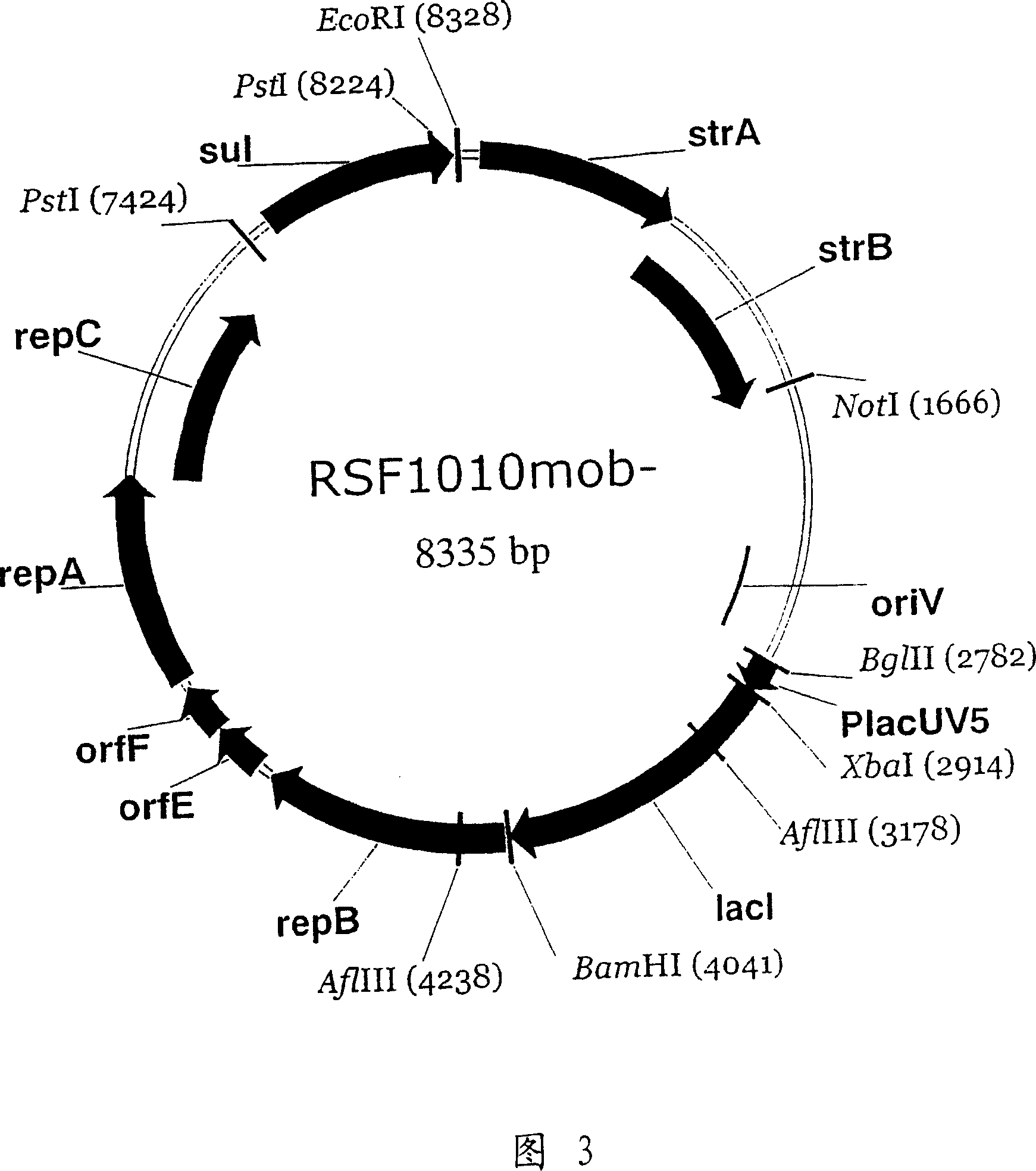Rsf1010 derivative mob' plasmid containing no antibiotic resistance gene, bacterium comprising the plasmid and method for producing useful metabolites
1. The technology of RSF1010 and metabolites, applied in the field of mutant vectors, can solve the problems of restricting recombinant strains, not describing the stability of RSF1010 and its derivatives, and not being able to identify plasmid stability determinants, etc.
- Summary
- Abstract
- Description
- Claims
- Application Information
AI Technical Summary
Problems solved by technology
Method used
Image
Examples
Embodiment 1
[0079] Example 1. RSF1010mob - Plasmid construction
[0080] By including the autonomous regulatory element P lacUV5 - DNA fragment "Red-driven integration" of lacI (Datsenko K.A. and Wanner B.L., Proc. Natl. Acad. Sci. USA, 2000, 97:12:6640-45) into the RSF1010 plasmid to replace the mob locus, to Conduct RSF1010Mob - Construction of the plasmid, the autonomous regulatory element P lacUV5-lacI is marked by the chloramphenicol resistance gene (cat gene).
[0081] First, with primers P1 (SEQ ID NO: 29) and P2 (SEQ ID NO: 30) and pMW-P lacUV5 - lacI-118 plasmid (Skorokhodova, A.Y. et al., Biotechnologiya (rus), No.5, (2004)) was used as a template to amplify P lacUV5 DNA fragment with the structural part of the lacI gene under the control of the promoter. P lacUV5 The nucleotide sequence of the promoter is disclosed in Genbank Accession No. Y00412 (nucleotides 7-100). The nucleotide sequence of lacI is disclosed in Genbank Accession No. NP_414879. In addition, the P use...
Embodiment 2
[0096] Example 2. mob of RSF1010 plasmid with increased copy number - Construction of Derivatives
[0097] According to our data, during the quiescent period, RSF1010mob - Has the same copy number as RSF1010. In the logarithmic phase of growth, the copy number of the obtained derivative was approximately two-fold lower than that of the RSF1010 plasmid. In logarithmic growth phase, addition of IPTG to the medium resulted in RSF1010mob - Plasmid copy number increases because the repB gene involved in replication of RSF-like plasmids is in the P lacUV5 -under the transcriptional control of the lacI autonomous regulatory element. Therefore, proposed from RSF1010mob - Elimination of the lacI gene in the plasmid can increase the copy number of the plasmid. by using XbaI and BamHI restriction enzymes from RSF1010mob - Plasmid excision of the lacI gene to obtain RSF1010mob without the lacI gene - corresponding derivatives. Then, the sticky ends of the resulting DNA fragments ...
Embodiment 3
[0101] Example 3. RSF1010Mob lacking any antibiotic resistance genes and containing thyA gene as selectable marker - Plasmid construction.
[0102] First, two strains were constructed based on the wild-type E. coli strain MG1655; one strain lacked the thyA gene, and the other lacked the tdk gene. The so-called "Red-driven integration" method (Datsenko K.A. and Wanner B.L., Proc.Natl.Acad.Sci.USA, 2000, 97:12 :6640-45) for the inactivation of target genes. The chloramphenicol resistance gene from plasmid pACYC184 was used to disrupt the thyA gene (Cm r ), the kanamycin resistance gene from plasmid pACYC177 was used to disrupt the tdk gene (Km r ). The two obtained mutants carrying antibiotic resistance markers can be used as donors to transduce ΔthyA and Δtdk deleted P1 into another E. coli strain.
[0103] Strains with a thyA deletion were used in the present invention to screen for functionally active copies of the thyA gene cloned on different plasmids.
[0104] The se...
PUM
 Login to View More
Login to View More Abstract
Description
Claims
Application Information
 Login to View More
Login to View More - R&D
- Intellectual Property
- Life Sciences
- Materials
- Tech Scout
- Unparalleled Data Quality
- Higher Quality Content
- 60% Fewer Hallucinations
Browse by: Latest US Patents, China's latest patents, Technical Efficacy Thesaurus, Application Domain, Technology Topic, Popular Technical Reports.
© 2025 PatSnap. All rights reserved.Legal|Privacy policy|Modern Slavery Act Transparency Statement|Sitemap|About US| Contact US: help@patsnap.com



